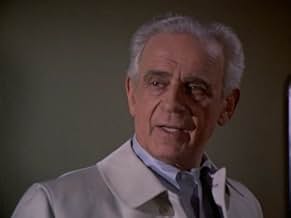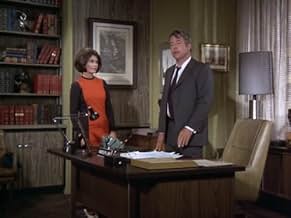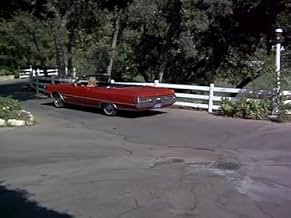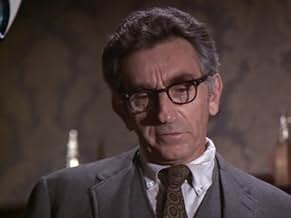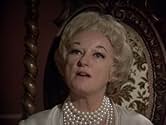Rod Serling presents tales of horror illustrated in various paintings.Rod Serling presents tales of horror illustrated in various paintings.Rod Serling presents tales of horror illustrated in various paintings.
- Nominated for 2 Primetime Emmys
- 2 wins & 4 nominations total
Browse episodes
Featured reviews
Rod Serlings follow up to Twilight Zone. This series originally began as a four in one alternating with three other shows and each would get one airing per month. Night Gallery was easily the best and became a weekly. While Twilight Zone dealt with Science Fiction Gallery dealt on the macabre horror side. Rod as host would introduce each story via a painting.
A few (mostly the short ones) had tongue in cheek humor. The others could be very spooky. The theme music was equally eerie. The show now airs on the Sci-Fi channel. Having watched it when it originally aired it seems that the episodes are edited here and there. Later episodes were added from another series entitled The Sixth Sense and they were not nearly as good as the Serling ones.
A few (mostly the short ones) had tongue in cheek humor. The others could be very spooky. The theme music was equally eerie. The show now airs on the Sci-Fi channel. Having watched it when it originally aired it seems that the episodes are edited here and there. Later episodes were added from another series entitled The Sixth Sense and they were not nearly as good as the Serling ones.
I grew up watching this as a really little kid in Brooklyn, my family loved this show and it's probably the reason I still suffer from Night Terrors to this DAY! I was 5 when I saw 1971 episode THE DOLL. (there are 2 different doll episodes, I think the other is from 73 and is called Doll of Death)
Anyhoo, I was SO FREAKED out from watching that 71 The Doll episode that I still remember having horrible nightmares as a kid and I called the Episode The Doll with the Black Eyes. I couldn't sleep in a room with dolls, and I had a new strange raggedy ann type doll my aunt had just bought me, and she had Solid Black Eyes. I loved that doll, but could not sleep with it in my bed or anywhere in my room at night after this episode. I would make my Mom lock it up every night. Seriously!! I Never wanted to re-watch that episode growing up and even as an adult cannot sleep in any room with dolls. I finally re-watched this in 2004, I'm a grown woman and YES, it still CREEPED ME OUT!! It's like this episode gave me PTSD as a kid, and all those feelings of Terror came flooding back. I know, it sounds crazy, but it's TRUE! I haven't watched it since. LOL I'm creeped out just writing this and remembering how terrorized I felt as a child. Rod Serling was Great and I love him to this day, but his show Freaked me out and left my sleep disturbed to this day. But weird thing is I always Loved Horror Movies and can watch The Walking Dead alone at night with no problems, but Don't play the Doll with the Black Eyes for me, cause I don't think I will sleep for days. :o Great old school series with alot of creepy and disturbing episodes. ;D.
One of the most underrated TV series of the 1970s, and of all time, is this terrific collection of sci-fi and horror stories, hosted by Rod Serling. Often (wrongly) compared to Serling's other series, "The Twilight Zone"...the overall mood, and purpose of this series is different. The "Zone" was a collection of morality tales, disguised as sci-fi stories. A fantastic show, without a doubt, but the "Gallery" was designed purely to shock and entertain...and it certainly succeeded in that area.
So much great talent was on display in this series. The actors, writers, directors, and musicians were almost always top-notch. Though the decision to have multiple stories within each episode, did result in some mediocre results sometimes (especially with the campy vignettes), the quality of the better segments is what most remember best.
Among some of the better segments:
"They're Tearing Down Tim Riley's Bar", with William Windom (in an awesome performance) as a has-been salesman who's beckoned by the ghosts of his past.
"The Doll", about a gruesome doll, sent to a British officer as revenge.
"The Tune in Dan's Cafe", about a haunted jukebox that plays the same song always.
"Green Fingers", with Elsa Lanchester as an elderly woman, harassed by a tycoon who wants her land, where she has an unusual knack for gardening.
So many more great ones. Some folks get turned off by the dated 1970s look to this show (the costumes, sets, bright color, excessive use of zooms/close-ups). If you can get past that aspect, and rather appreciate the show's camp value, you're sure to enjoy this unique and highly original horror series. It's a classic in my book.
So much great talent was on display in this series. The actors, writers, directors, and musicians were almost always top-notch. Though the decision to have multiple stories within each episode, did result in some mediocre results sometimes (especially with the campy vignettes), the quality of the better segments is what most remember best.
Among some of the better segments:
"They're Tearing Down Tim Riley's Bar", with William Windom (in an awesome performance) as a has-been salesman who's beckoned by the ghosts of his past.
"The Doll", about a gruesome doll, sent to a British officer as revenge.
"The Tune in Dan's Cafe", about a haunted jukebox that plays the same song always.
"Green Fingers", with Elsa Lanchester as an elderly woman, harassed by a tycoon who wants her land, where she has an unusual knack for gardening.
So many more great ones. Some folks get turned off by the dated 1970s look to this show (the costumes, sets, bright color, excessive use of zooms/close-ups). If you can get past that aspect, and rather appreciate the show's camp value, you're sure to enjoy this unique and highly original horror series. It's a classic in my book.
There is something that sets Night Gallery apart from all other sci-fi/thriller TV shows. An ethereal element of mystique lurks within every episode that provides for unique entertainment. Narrated by Rod Serling, Night Gallery explores the supernatural from the context of an abstract painting--a different painting each episode. When narrating his previous series, The Twilight Zone, Serling generally manifested an air of superiority to the plot--like he had it in the palm of his hand and could control it. In Night Gallery, however, he relinquishes such control and becomes more a PART of the madness; as if the gallery is controlling HIM (it is also refreshing to finally view him in color). Night Gallery episodes are NOT concluded with a Serling anecdotal summary; instead, a shocking punch is usually delivered that the viewer is left to unravel without assistance.
The directing and editing are top notch. Scenes cascade in a swift and somewhat ambiguous fashion, and camera tricks are cleverly exploited to hold our attention--proving that today's computer graphics are not essential to exact viewer interest. Simple story lines are translated into convoluted journeys of intrigue with music and sound effects akin only to The Exorcist.
Some memorable episodes include Sally Field playing a woman with multiple personalities (this was before she played Cybil, mind you); an ostracized young girl who befriends a seaweed monster; a diner jukebox that hauntingly plays only one song; a man who has an earwig planted in his ear that creeps through his brain (and lays eggs!); and a young Clint Howard (Ron's kid brother) playing a child prodigy who foresees mankind's treacherous fate.
Of course, there are those little, campy vignettes thrown in for fun, most of which are mildly amusing. Overall, this is an exhibit you will not want to bypass!
The directing and editing are top notch. Scenes cascade in a swift and somewhat ambiguous fashion, and camera tricks are cleverly exploited to hold our attention--proving that today's computer graphics are not essential to exact viewer interest. Simple story lines are translated into convoluted journeys of intrigue with music and sound effects akin only to The Exorcist.
Some memorable episodes include Sally Field playing a woman with multiple personalities (this was before she played Cybil, mind you); an ostracized young girl who befriends a seaweed monster; a diner jukebox that hauntingly plays only one song; a man who has an earwig planted in his ear that creeps through his brain (and lays eggs!); and a young Clint Howard (Ron's kid brother) playing a child prodigy who foresees mankind's treacherous fate.
Of course, there are those little, campy vignettes thrown in for fun, most of which are mildly amusing. Overall, this is an exhibit you will not want to bypass!
I vaguely remember watching this show when I was a small child when it was a regular series. I watched it in syndication when I was an adolescent and have watched it as an adult on the Sci-Fi channel, so I guess that you could say I have had a chance to view Night Gallery from three very different perspectives. Rod Serling was a true genius who was often called television's "first angry man". What I mean is that he wrote scripts for tv that dealt with real social issues and were not meant as fluff entertainment. He wanted to send out a message with the stories that he wrote. Serling wrote such classic screenplays as Requium For A Heavywieght and Patterns. He probably would not have liked it that he was best remembered for The Twilight Zone! Night Gallery was the last series he hosted before his untimely death in 1975. Each episode had about three or four stories. Of course they didn't hit the target with all of them, but they still had a good batting average! Some of the episodes were disturbing and terrifying and some were just meant to be merely humerous. I remember one with Leslie Nielsen as the Phantom of the Opera (keep in mind this was before the Naked Gun and Police Squad when he was a dramatic actor). The girl unmasked him and he unmasked her and found she was as deformed as he was! They had another episode that I clearly remember about a time traveler who was a survivor of the Titanic who was picked up by the Lusitania who was then rescued by the Andrea Doria! The one that I remember the most, the one that chilled me was the one about a boy who could see the future and then described a horrifying vision where the sun would explode (a nova) and would incinerate the earth! The fun part of this show was the high quality of the guest stars that they had everyone from Burgess Meredith to Ozzie and Harriet Nelson to Leonard Nimoy. Gary Collins was Night Gallery's most frequent guest star, he played a parapsychologist named Doctor Rhode's who investigated all kinds of odd cases and his character was so popular that he even got his own series. I always enjoyed every episode that Mister Collins was in. People don't realize this, but the original Night Gallery movie in 1969, the series pilot was one of the first television movies ever made! In fact, one of the directors who did one of the stories was a young man named Steven Spielburg! The story I most remember from the pilot was one with Richard Kiley as a Nazi War Criminal who meets a truly just and horrifying end. A man who put too many Christs on crosses for any God to give him forgiveness! Rod Serling fought in World War II as a paratrooper and was severely wounded. His wife said in an interview that he never stopped having nightmares about the war and many of the stories he wrote for the Twilight Zone and Night Gallery deal with the horrors of war. Rod Serling was a true genius who wrote stories that entertained us and made us think at the same time.
Did you know
- TriviaArtist Thomas J. Wright painted all of the paintings used to introduce each story.
- Quotes
Rod Serling: For those of you who've never met me, you might call me the under-nourished Alfred Hitchcock.
- Alternate versionsMajor changes were made to most episodes for syndication. The 60-minute episodes were edited down to 30 minute packages, with major edits to some of the 30-40 minute segments of the original shows. In cases of segments that were only 15-20 minutes in length, these were padded out by adding stock footage, newly shot scenes, and footage from Hollywood movies such as Silent Running (1972) and Fahrenheit 451 (1966). Most musical cues were also replaced for syndication. In order to augment "Night Gallery"'s syndicated run, episodes of Le sixième sens (1972) were edited down to 30 minutes, had new introductions by Rod Serling tacked on, and were added to the syndicated run of "Night Gallery."
- ConnectionsEdited from Four-In-One (1970)
- How many seasons does Night Gallery have?Powered by Alexa
Details
- Release date
- Country of origin
- Language
- Also known as
- Rod Serling's Night Gallery
- Filming locations
- Production company
- See more company credits at IMDbPro
- Runtime
- 50m
- Sound mix
- Aspect ratio
- 1.33 : 1
Contribute to this page
Suggest an edit or add missing content


